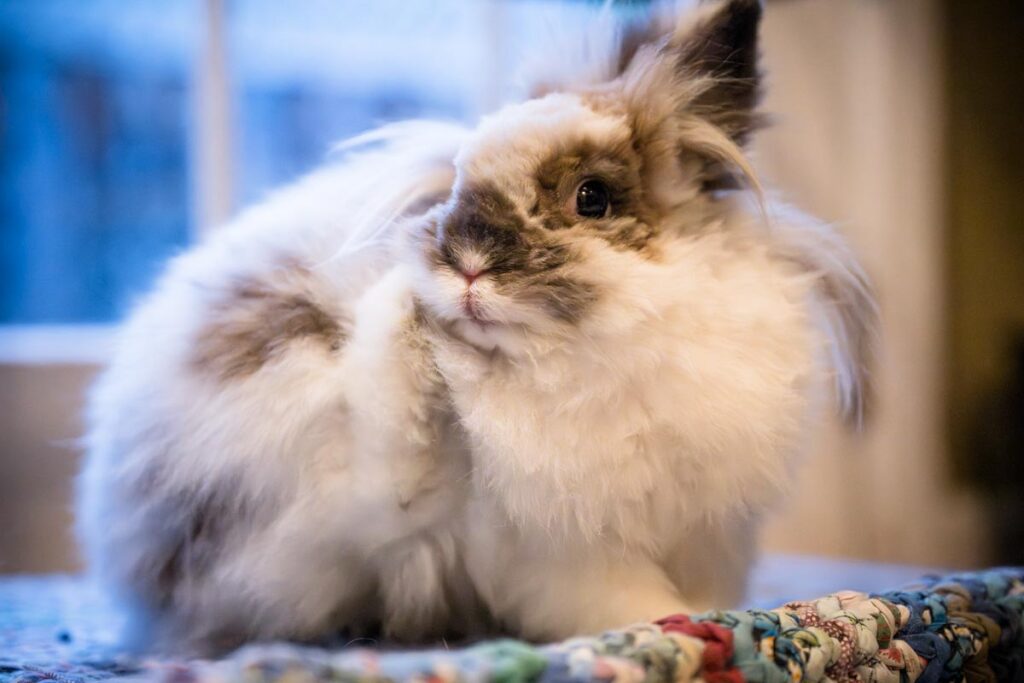The skin of rabbits is a window to their general state of health. Skin ailments range from irritating to life-threatening. Some are contagious to other species, including humans. Proper treatment is immensely rewarding, as it returns our rabbits to their normal state of inquisitive cheerfulness.
Alopecia
Fur loss in rabbits with no other lesions can have many different causes, including fur-plucking, barbering, hormonal problems, and previous localized inflammation. Fur-plucking in the neck or dewlap, belly, and leg areas occurs in pregnant females who are close to delivery, to line their nest. Even pseudopregnant females sometimes pluck in that area. Fur-plucking may also be seen in cases of nutritional deficiency such as when they lack sufficient fiber in the diet. Rabbits who cannot reach the site of an irritation because of arthritis, obesity, or intervening skin folds sometimes chew at their dewlap instead. Simple baldness may result, but frequently the skin also appears irritated.
The fur at the nape of the neck is normally thin. Coat density in this area may change with the seasons or with hormonal fluctuations in unspayed females. If the bald spot is limited to the area hidden when the rabbit tucks her head back toward her shoulders. If the hair is thin beyond this spot, it is a good idea to have your veterinarian do an examination.
Barbering, or chewing on the hair, is sometimes seen when rabbits are housed together or with guinea pigs. Rabbits may chew on their own hair or on each other’s hair. The stress of crowding is likely to intensify the problem. Barbered areas show patchy hair loss with broken hairs present (they have been nipped off) without complete baldness.
Occasionally hair loss can be seen at the site of a previous bite wound or other injury.and is related to the healing process. Hair should regrow within a few months in these cases unless there was extensive scarring and deep damage to the skin.
Mites in Ears, Fur, or Skin
During normal shedding, the undercoat may come out in clumps, but no flaking should be seen. Patchy fur loss with mild to severe flaking along the rabbit’s back is the hallmark of Cheyletiella parasitovorax, the most common rabbit skin mite. Hairs at the border of the bald spot come out easily in clumps, usually with some coarse flakes of skin attached. Fur mites may or may not cause itching. Your veterinarian may examine a scotch-tape preparation or skin scraping under the microscope for the presence of mites, but mites are sometimes difficult to detect. Luckily, mites are usually eradicated with relative ease. Classic treatment is with injectable or oral ivermectin, given in treatments two weeks apart. More recently, Revolution (selamectin) has been used effectively. A kitten dose of Revolution is applied between the shoulder blades and is repeated weekly for at least three doses. Revolution is dosed within a broad range of 6–20 mg/kg, with recent studies and guidelines recommending the higher end of this range for optimal effectiveness1. If you have the 60mg/ml solution (i.e. the kitten solution), use 0.3cc per kg of body weight (1kg = 2.2lb). If you have the 120mg/ml solution, use 0.15cc per kg of body weight. A dosing calculator can be found here. You’ll need a tuberculin syringe (no needle!) from your vet to measure such a small quantity of liquid. Apply to the back of the neck or other area where the bunny can’t readily groom it off. It is essential to thoroughly clean your rabbit’s cage and exercise areas after each treatment to control reinfestation, since fur and dander in the environment may contain mite eggs.
The rabbit ear mite, Psoroptes cuniculi, produces abundant red-brown crusts in the ear canal. The rabbit may shake his head or scratch at his ears or one or both ears may droop. This is a very uncomfortable disease. Mites may be seen with the naked eye, moving along the crusts. If they are not grossly visible they are easily detected via microscopic examination of the crusts and debris from the ear. These mites can also be found on other areas of the skin, most commonly just above the tail, where they cause itching and crusts. Injectable or oral ivermectin has traditionally been the treatment of choice but Revolution, used in the same manner as for Cheyletiella has proven safe and effective. It is not necessary to clean the ears and remove the crusts which is extremely painful. Once either ivermectin or Revolution and the mites are killed, healing progresses rapidly and the crusts come out on their own. It is important as with the fur mites, the clean the rabbit’s environment after each treatment as a few mites may be present in the bedding from time to time.
Fleas
Fleas can cause hair loss, redness, small crusts, and itching. Advantage (imidacloprid) or Revolution, both used at a kitten dose or cat dose depensing on the size of the rabbit, applied topically once a month have been used quite successfully. The rabbit’s environment must also be treated. Environmental treatment with insect growth regulators (IGRs) and insecticide sprays has proven safe as long as the rabbits are removed until the product has dried. Application of borate powder (Fleabusters TM) to rugs is also safe and effective.
A Warning About Baths
Reports have been received of shock or death in rabbits following the use of insecticidal dips or baths that are usually considered safe. Products involved have included carbaryl dips, carbaryl shampoo, pyrethrin dips, pyrethrin shampoo followed by carbaryl dip, lime sulfur dips, and even baby shampoo. The wide variety of products involved and the lack of symptoms usually associated with insecticide toxicity suggest that the reaction is initiated by the stress of bathing, dipping, or drying, rather than by the chemicals themselves. Overheating, chilling, or liver problems (common in overweight or anorectic rabbits) may be critical factors as well. Rabbits should always be observed after bath or dip for signs of shock-pale mucous membranes, severe depression, or weakness. Immediate supportive care (warm IV fluids, warmth, corticosteroids, etc.) can be provided if problems develop. Fatalities sometimes result despite prompt treatment.
Chronic Wetness Leads to Problems
If a rabbit’s skin is chronically exposed to moisture, then baldness, redness, and crusting may develop, and bacterial infection may follow. The source of the moisture may be the environment (water crocks, leaky water bottle, damp litter, overgrooming by another rabbit) or the rabbit’s own body fluids (urine leakage, fecal staining, drooling due to dental problems, or eye discharge). Infection by the bacterium Pseudomonas aeruginosa sometimes causes a moist dermatitis which shows as a blueish discoloration of the fur. If drinking water is contaminated with Pseudomonas, rigorous disinfection or replacement of water containers is essential.
Finding out where the moisture is coming from and eliminating the source is the first and most important step toward a cure. Steps may include veterinary treatment for problems like arthritis, bladder problems , or conjunctivitis (see HRJ III, 5), or a change in diet to correct obesity (see HRJ III, 3,4). Rabbits with these problems should not be allowed outdoors because they are at for fly strike.
Daily care of the affected area is necessary and may include clipping, cleansing with chlorhexidine or tamed iodine solution, and applying topical antibiotic/anti-inflammatory powder or ointment. Intensive or prolonged use of topical corticosteroids can have systemic effects and should be avoided. Systemic antibiotics (based on culture/sensitivity testing) are needed if there is pus, fever, or lethargy.
Pododermatitis (sore hock)
Pododermatitis (sore hock) is most commonly seen in rabbits housed on wire or other rough, wet, or hard surfaces, but may occur in rabbits who are never caged. Heavy-bodied breeds (Flemish Giant, Californian), obese rabbits, and those with thin fur on the bottoms of their feet (Rex) are predisposed to this problem. In simple cases, providing a soft absorbent resting surface (cotton toweling or artificial fleece are ideal if the rabbit doesn’t chew them), cleaning the underside of the foot, and applying a padded wrap for 1-2 weeks will help effect a cure. Topical use of Preparation H or Bag Balm are folk remedies that can be effective. Weight reduction can be the key to a cure in overweight rabbits. For cases with severe infection or deep ulceration, X-rays to determine if the infection has penetrated into the bone, culture/sensitivity testing, and appropriate systemic antibiotics are recommended. Hocks with severe infection or deep ulceration may be difficult or impossible to cure. If the infection has penetrated the bone and only one foot is infected severely, amputation may be necessary to provide relief from pain.
Ringworm
Ringworm is not a worm but a fungus that takes its name from the classic raised red circular lesion with a clearing center that can be a primary symptom. However, crusting, scaling, and bald spots are actually more common symptoms than the red ring. Ringworm most commonly occurs on the rabbit’s head, ears, and face. Treatment with ProgramTM has been found to be quite effective. Your veterinarian may provide topical treatment (miconazole, clotrimazol) for small lesions.
Rabbit Syphilis
Treponema cuniculi is a bacteria called a spirochete similar to that which causes syphilis in humans. It causes crusty dermatitis primarily around the rabbit’s genitals or nose but in severe cases is can extend upwards on the face and around the eyes.. This organism is resistant to most topical treatments but responds well to procaine penicillin G injections. One must take care and watch for intestinal upset during this treatment.
Lumps, Bumps, Cancer
Abscesses are the most common skin swellings in rabbits. Because the pus produced by rabbits often has a thick cream cheese-like consistency and is encased in a thick capsule, lancing, draining, and systemic antibiotics often fail to effect a cure. Complete surgical removal of the intact abscess is preferred. There are a wide range of potential treatments for abscesses that are not able to be surgically removed for whatever reason. The most important thing is to get an anaerobic and an aerobic culture prior to any treatment to determine what the most appropriate antibiotic will be to give either systemically and/or into the abscess cavity itself. Treatments range from cleaning the abscess and implanting antibiotic impregnanted beads to leaving it open and packing and/or flushing with a variety of medications. It is best to consult your veterinarian to determine what is the most appropriate regime of treatment for your individual rabbit.
The most common cause of lumps and bumps on rabbits are warts, caused by a papilloma virus and benign growths such as fatty tumors (lipomas). Malignant skin cancers are not common in the rabbit, but do occur and are most often a metastasis of another cancer, most noteably uterine cancer. Any unusual growths on the skin should be watched for change in size, shape, or color and should be evaluated by a veterinarian. If a skin mass is removed, it is a good idea to have your veterinarian send it out for pathology so it can be identified and any further treatment can be instituted if necessary.
The skin ailments mentioned here are not all-inclusive. Home remedies are typically ineffectual and may lead to complications or even death. It is always best to consult your veterinarian rather than attempting home diagnosis and treatment.
©Copyright Kathleen Wilsbach. All Rights Reserved. Republished with the permission of the author.
Skin Diseases in Rabbits: Common Causes, Common Treatments was originally published in House Rabbit Journal v4i9

